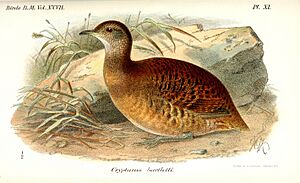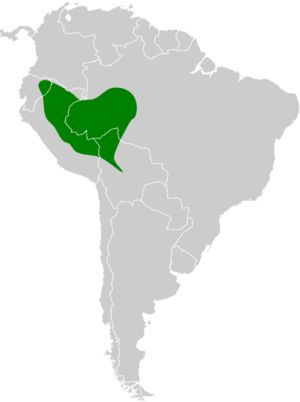Bartlett's tinamou facts for kids
Quick facts for kids Bartlett's tinamou |
|
|---|---|
 |
|
| Picture by Christopher, 2009 | |
| Conservation status | |
| Scientific classification | |
| Genus: |
Crypturellus
|
| Species: |
bartletti
|
 |
|
| Synonyms | |
|
|
The Bartlett's tinamou (Crypturellus bartletti) is a special kind of bird. It lives in the low-lying forests of South America. This bird is part of a group called tinamous.
Contents
What is a Bartlett's Tinamou?
The Bartlett's tinamou is a unique bird. It belongs to the Tinamidae family. All tinamous are also part of a larger group called ratites. You might know other ratites like ostriches or emus.
Tinamous and Other Ratites
Most ratites cannot fly. But tinamous are different! They can fly, even if they are not super strong fliers. Scientists believe that all ratites came from ancient flying birds. Tinamous are the closest living relatives to these old flying birds.
What Does Its Name Mean?
The scientific name for this bird is Crypturellus bartletti. Let's break down what that means!
The Meaning of Crypturellus
The word Crypturellus comes from three old Latin or Greek words:
- Kruptos means covered or hidden.
- Oura means tail.
- Ellus means small or diminutive.
So, Crypturellus means "small hidden tail." This describes how their tails are often hard to see.
Who Was Bartlett?
The second part of the name, Bartletti, is in honor of a person. It comes from the Latin form of Bartlett. This name was given to remember Edward Bartlett.
Where Does It Live?
The Bartlett's tinamou lives in certain parts of South America. It prefers swampy and lowland forests. These forests are found in warm, wet areas.
Its Home in South America
You can find this tinamou in:
It usually lives in places up to about 500 meters (1,640 feet) high. Even though it lives in a large area, it is not very common to see.
What Does It Look Like?
The Bartlett's tinamou is about 27 centimeters (10.6 inches) long. That's about the size of a ruler!
Its Colors and Markings
- Its upper parts are brown with black stripes.
- Its throat and belly are white.
- The rest of its underside is a reddish-brown color.
- Its sides have black stripes.
- The top of its head is blackish.
How Does It Behave?
Like other tinamous, the Bartlett's tinamou has interesting habits.
What It Eats
This bird mostly eats fruit that has fallen to the ground. It also eats fruit from low bushes. Sometimes, it will also snack on:
- Small invertebrates (like insects)
- Flower buds
- Tender leaves
- Seeds
- Roots
Raising Its Young
The male Bartlett's tinamou is a very dedicated parent!
- He incubates the eggs. These eggs might come from up to four different females.
- He then raises the young birds.
- The young tinamous stay with their father until they are ready to be on their own. This usually takes about two to three weeks.
- Their nest is built on the ground. It's often hidden in thick bushes or between large tree roots.
Is It Safe?
The IUCN (International Union for Conservation of Nature) keeps track of how many of these birds there are.
Conservation Status
They have classified the Bartlett's tinamou as "Least Concern". This means that there are enough of them in the wild right now. Their habitat covers a huge area, about 1,600,000 square kilometers (617,763 square miles).


